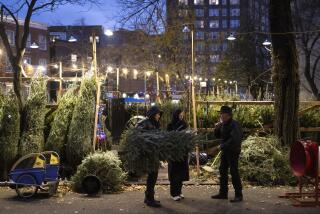‘Tis the Season of Toys and Trees
The fever pitch of holiday preparations is rooted in a couple of old traditions, the Christmas tree in the living room and a pile of toys underneath.
Every holiday season, there is a new or special toy wanted by America’s children; this year’s favorites--Nintendo 64, Tickle Me Elmo and Happy Holidays Barbie--are in short supply. But some toys are classics, having been with us for more than 50 years .
1900: Lionel Trains
Jousha Lionel Cowen invented the first electric toy train, which consisted of one wooden car that ran around a circular track. In 1902, the first accessory--a suspension bridge--was issued, followed the next year by the Baltimore & Ohio locomotive. Nearly 1 million engines, cabooses, and other rolling stock are produced annually. That’s enough to make a toy train nearly 50 miles long.
1903: Crayola Crayons
Crayola means “oily chalk.” The name was derived from the French word craie , meaning chalk, and ola from oleaginous. At Binney & Smith, more than 2 billion crayons, made from paraffin wax and colored pigments, come off the assembly line each year. The average American child wears down 730 crayons by the age of 10.
1913: Erector Sets
“Hello, boys! Makes lots of toys,” was the headline in the national ads for the first Erector Sets. Although little boys were the early targets, the tables have turned. The winners of a national contest in 1993 were five little girls from Brooklyn, N.Y., who built a bridge.
1914: Tinkertoys
Tinkertoys were designed by Charles Pajeau, a professional tombstone cutter, after watching children playing with sewing spools and pencils. In 1914, midgets dressed like elves assembled Tinkertoys in store windows in Chicago and New York to promote the new toy. In 1992, Playskool introduced the first all-plastic, brightly colored version.
1916: Lincoln Logs
Developed by John Lloyd Wright, son of architect Frank Lloyd Wright, who conceived the idea after viewing the Imperial Hotel in Tokyo. The round canister containing dark rosewood colored wooden logs and green roof slats appeared under many Christmas trees during the ‘20s. The Davy Crockett craze of the 1950s brought a resurgence of Lincoln Log popularity.
1917: Radio Flyer Wagon
Founded by Antonio Pasin, a European immigrant who set up a one room cabinet-making shop in Chicago. Pasin spent his evenings making wooden wagons. In the 1920s, as the automobile industry developed the technology, stamped steel wagon bodies went into production. On exhibit at the 1933 World’s Fair in Chicago was a 45-foot-tall statue of a boy riding a gigantic red Radio Flyer wagon.
1935: Monopoly
Legend says Charles Darrow drew the first Monopoly game on a piece of oilcloth on his kitchen table. It was during the Depression, and the unemployed Darrow was reminiscing about his childhood days in Atlantic City. The game is licensed in 33 countries and printed in 23 different languages. Cubans cannot buy Monopoly in their homeland. President Fidel Castro had all known sets seized and destroyed after he denounced the game as “symbolic of an imperialistic and capitalistic system.”
1945: Slinky
Marine engineer Richard James was working on a testing meter on his desk when a torsion spring fell off and bounced onto the floor. He watched in amazement as the spring tumbled end-over-end. James took the spring home and worked out a steel formula that allowed the spring to “walk.” Slinkys are now available in several sizes in coated steel or plastic. More than 250 million have been sold since 1945.
Source: Toy Manufacturers of America and individual manufacturers
Researched by EDITH STANLEY / Los Angeles Times
O Christmas Tree
The tradition of the Christmas tree dates back to the Middle Ages and caught on in the United States in the 1800s. Today approximately 15,000 U.S. growers tend 1 million acres of Christmas tree farmland. Prices this year will remain steady at an average of about $5.65 per foot. A look at holiday evergreens.
Popular trees
Arizona cypress
Balsam fir**
Blue spruce
Canaan fir
Concolor fir
Douglas fir**
Eastern red cedar
Eastern white pine**
Fraser fir**
Grand fir
Leyland cypress
Noble fir**
Norway spruce
Scotch pine**
Virginia pine**
White spruce
****
Christmas trees sold (In millions)
1996*: 37 million
* Projected
Sources: National Christmas Tree Assn., “The Everything Christmas Book,” “The Tree & Shrub Expert” and “Trees of North America” via Associated Press
More to Read
Sign up for The Wild
We’ll help you find the best places to hike, bike and run, as well as the perfect silent spots for meditation and yoga.
You may occasionally receive promotional content from the Los Angeles Times.






